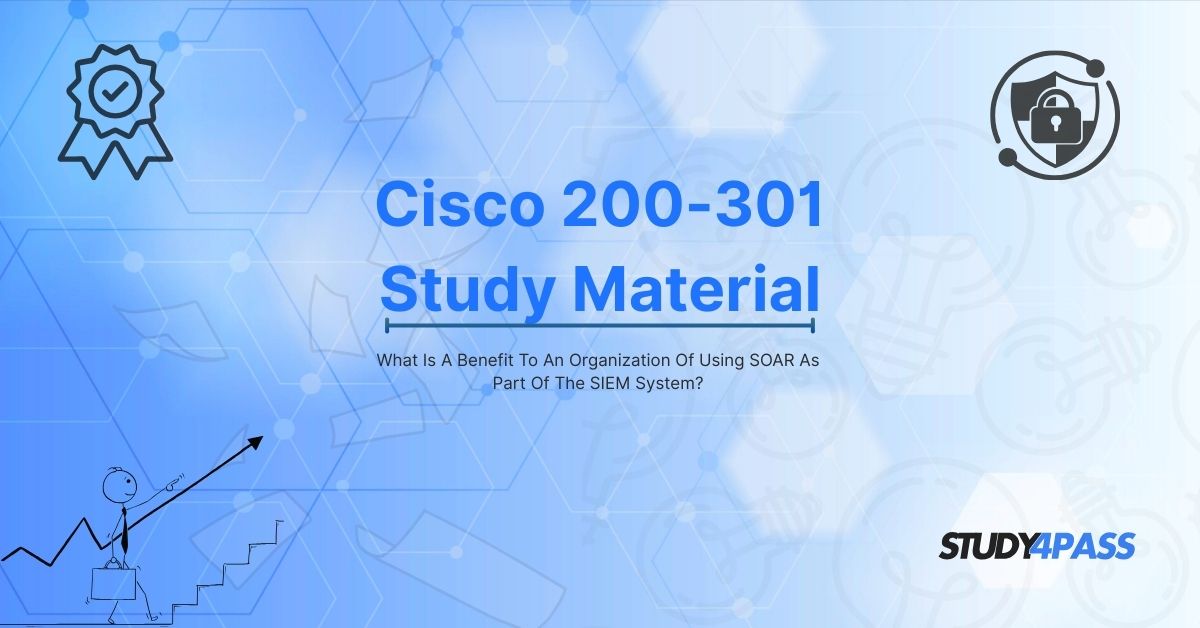Introduction to SOAR
In today’s rapidly evolving cybersecurity landscape, organizations face an increasing number of sophisticated threats. Security Information and Event Management (SIEM) systems have long been a cornerstone of enterprise security, providing real-time analysis of security alerts. However, as cyber threats grow in complexity, traditional SIEM solutions alone may not be sufficient. This is where Security Orchestration, Automation, and Response (SOAR) comes into play.
Integrating SOAR with SIEM enhances an organization’s ability to detect, analyze, and respond to security incidents efficiently. This article explores the key benefits of using SOAR as part of the SIEM system, its relevance to CCNA CyberOps and Cisco 200-301 certification studies, and how Study4Pass can help IT professionals master these concepts.
Understanding SIEM and SOAR
What is SIEM?
A SIEM (Security Information and Event Management) system collects, correlates, and analyzes log data from various sources within an organization’s IT infrastructure. It provides:
- Real-time threat detection
- Log management and compliance reporting
- Incident investigation capabilities
However, SIEM systems generate a high volume of alerts, many of which are false positives, leading to alert fatigue among security teams.
What is SOAR?
SOAR (Security Orchestration, Automation, and Response) is a technology that:
- Orchestrates security tools and workflows
- Automates repetitive tasks
- Enhances incident response through playbooks
By integrating SOAR with SIEM, organizations can streamline security operations, reduce response times, and improve overall cybersecurity posture.
Key Benefits of Using SOAR with SIEM
1. Faster Incident Detection and Response
- SIEM identifies threats, while SOAR automates the response.
- Reduces Mean Time to Detect (MTTD) and Mean Time to Respond (MTTR).
- Automated playbooks ensure consistent and rapid reactions to threats.
2. Reduction in Alert Fatigue
- SIEM generates numerous alerts, many of which are false positives.
- SOAR filters and prioritizes alerts, allowing analysts to focus on critical threats.
3. Improved Threat Intelligence Integration
- SOAR integrates with threat intelligence feeds to enrich SIEM data.
- Helps in identifying Indicators of Compromise (IoCs) more efficiently.
4. Enhanced Security Team Productivity
- Automates repetitive tasks such as log analysis and ticket creation.
- Frees up security analysts to focus on complex investigations.
5. Better Compliance and Reporting
- SOAR ensures consistent documentation of security incidents.
- Helps organizations meet GDPR, HIPAA, PCI-DSS, and other compliance requirements.
6. Cost Efficiency
- Reduces the need for a large security operations center (SOC) team.
- Lowers operational costs by automating manual processes.
7. Scalability for Growing Enterprises
- As organizations expand, SOAR scales to handle increased security workloads.
- Supports cloud, hybrid, and on-premises environments.
SOAR in CCNA CyberOps and Cisco 200-301 Certification
For IT professionals pursuing CCNA CyberOps or Cisco 200-301 certifications, understanding SIEM and SOAR is crucial. These certifications cover:
- Security monitoring and analysis
- Incident response procedures
- Automation in cybersecurity
Why Study4Pass is the Best Resource for Certification Preparation?
Study4Pass provides high-quality study materials, including:
- Detailed guides on SIEM and SOAR integration
- Practice exams for CCNA CyberOps and Cisco 200-301
- Real-world case studies on security automation
By leveraging Study4Pass, candidates can gain hands-on knowledge and pass their Cisco certification exams with confidence.
Final Verdicts
Integrating SOAR with SIEM significantly enhances an organization’s cybersecurity capabilities by improving threat detection, reducing response times, and increasing operational efficiency. For professionals preparing for CCNA CyberOps or Cisco 200-301, mastering these concepts is essential.
Study4Pass offers the best study materials to help IT professionals excel in their certification journey. By choosing Study4Pass, learners gain access to expertly crafted resources that align with industry standards.
As cyber threats continue to evolve, organizations must adopt advanced security solutions like SOAR-integrated SIEM to stay protected. Investing in the right training through Study4Pass ensures that cybersecurity professionals are well-equipped to handle modern security challenges.
Special Discount: Offer Valid For Limited Time “200-301 Exam Format Prep”
Actual exam question from Cisco's 200-301 Study Guide.
Sample Questions for Cisco 200-301 Exam Questions
1. What is a primary benefit of integrating SOAR with a SIEM system?
a) Reduces hardware costs
b) Automates incident response and improves efficiency
c) Eliminates the need for cybersecurity staff
d) Increases internet bandwidth
2. How does SOAR enhance a SIEM system's capabilities?
a) By replacing the SIEM entirely
b) By providing manual analysis only
c) By enabling automated threat detection and response workflows
d) By slowing down alert processing
3. Which of the following is a key advantage of SOAR in a SIEM environment?
a) Decreases the number of security alerts generated
b) Reduces response time to security incidents
c) Requires more manual intervention
d) Limits integration with other security tools
4. SOAR helps organizations by:
a) Generating more false positives
b) Providing a centralized platform for managing and responding to security incidents
c) Increasing dependency on human analysts for every alert
d) Decreasing visibility into security events
5. What role does automation play in SOAR when combined with SIEM?
a) It complicates the incident response process
b) It helps in executing predefined actions for common threats without manual input
c) It reduces the need for logging security events
d) It prevents integration with threat intelligence feeds


